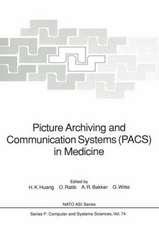Metadata-driven Software Systems in Biomedicine: Designing Systems that can adapt to Changing Knowledge: Health Informatics
Autor Prakash M. Nadkarnien Limba Engleză Paperback – 15 iul 2013
Many of the larger EMR or clinical research database vendors have realized this, but their designs are proprietary and not described in the literature. Consequently, numerous misconceptions abound among individuals who have not had to work with large-scale biomedical systems, and graduates of a health or bioinformatics program may find that they need to unlearn what they were taught in database and software design classes in order to work productively with such systems. A working knowledge of such systems is also important for individuals who are not primarily software developers, such as health informaticians, medical information officers and data analysts. This book is, in a sense, intended to prepare all of the above individuals for the real world.
| Toate formatele și edițiile | Preț | Express |
|---|---|---|
| Paperback (1) | 842.61 lei 6-8 săpt. | |
| SPRINGER LONDON – 15 iul 2013 | 842.61 lei 6-8 săpt. | |
| Hardback (1) | 728.16 lei 6-8 săpt. | |
| SPRINGER LONDON – 29 mai 2011 | 728.16 lei 6-8 săpt. |
Din seria Health Informatics
- 5%
 Preț: 429.40 lei
Preț: 429.40 lei - 5%
 Preț: 458.30 lei
Preț: 458.30 lei - 5%
 Preț: 326.78 lei
Preț: 326.78 lei - 5%
 Preț: 418.61 lei
Preț: 418.61 lei - 5%
 Preț: 353.45 lei
Preț: 353.45 lei - 5%
 Preț: 787.58 lei
Preț: 787.58 lei - 5%
 Preț: 1038.14 lei
Preț: 1038.14 lei - 5%
 Preț: 269.08 lei
Preț: 269.08 lei - 5%
 Preț: 488.26 lei
Preț: 488.26 lei - 5%
 Preț: 570.44 lei
Preț: 570.44 lei - 5%
 Preț: 404.78 lei
Preț: 404.78 lei - 5%
 Preț: 342.03 lei
Preț: 342.03 lei - 5%
 Preț: 416.38 lei
Preț: 416.38 lei - 5%
 Preț: 384.05 lei
Preț: 384.05 lei - 5%
 Preț: 341.48 lei
Preț: 341.48 lei - 5%
 Preț: 385.01 lei
Preț: 385.01 lei - 5%
 Preț: 363.07 lei
Preț: 363.07 lei - 5%
 Preț: 735.46 lei
Preț: 735.46 lei - 5%
 Preț: 769.80 lei
Preț: 769.80 lei -
 Preț: 384.86 lei
Preț: 384.86 lei - 5%
 Preț: 727.44 lei
Preț: 727.44 lei - 5%
 Preț: 719.74 lei
Preț: 719.74 lei - 5%
 Preț: 724.14 lei
Preț: 724.14 lei - 5%
 Preț: 649.68 lei
Preț: 649.68 lei - 5%
 Preț: 723.21 lei
Preț: 723.21 lei - 5%
 Preț: 589.18 lei
Preț: 589.18 lei - 5%
 Preț: 1104.48 lei
Preț: 1104.48 lei - 5%
 Preț: 366.70 lei
Preț: 366.70 lei - 5%
 Preț: 905.70 lei
Preț: 905.70 lei - 5%
 Preț: 717.00 lei
Preț: 717.00 lei - 5%
 Preț: 1122.94 lei
Preț: 1122.94 lei - 5%
 Preț: 731.80 lei
Preț: 731.80 lei - 5%
 Preț: 776.78 lei
Preț: 776.78 lei - 5%
 Preț: 844.27 lei
Preț: 844.27 lei - 5%
 Preț: 1102.10 lei
Preț: 1102.10 lei - 5%
 Preț: 380.25 lei
Preț: 380.25 lei - 5%
 Preț: 720.84 lei
Preț: 720.84 lei - 5%
 Preț: 771.30 lei
Preț: 771.30 lei - 5%
 Preț: 717.73 lei
Preț: 717.73 lei - 5%
 Preț: 388.48 lei
Preț: 388.48 lei - 5%
 Preț: 423.84 lei
Preț: 423.84 lei - 5%
 Preț: 724.50 lei
Preț: 724.50 lei
Preț: 842.61 lei
Preț vechi: 886.97 lei
-5% Nou
Puncte Express: 1264
Preț estimativ în valută:
161.23€ • 175.69$ • 135.86£
161.23€ • 175.69$ • 135.86£
Carte tipărită la comandă
Livrare economică 23 aprilie-07 mai
Preluare comenzi: 021 569.72.76
Specificații
ISBN-13: 9781447126621
ISBN-10: 1447126629
Pagini: 416
Ilustrații: XX, 396 p.
Dimensiuni: 155 x 235 x 22 mm
Greutate: 0.59 kg
Ediția:2011
Editura: SPRINGER LONDON
Colecția Springer
Seria Health Informatics
Locul publicării:London, United Kingdom
ISBN-10: 1447126629
Pagini: 416
Ilustrații: XX, 396 p.
Dimensiuni: 155 x 235 x 22 mm
Greutate: 0.59 kg
Ediția:2011
Editura: SPRINGER LONDON
Colecția Springer
Seria Health Informatics
Locul publicării:London, United Kingdom
Public țintă
Professional/practitionerCuprins
1. What is metadata? Types of metadata.- Descriptive (interpreted by humans).- Technical (utilized by software).- Some metadata shows characteristics of both.- How metadata is represented.- Why use metadata to build biomedical systems? Caveat: Metadata-driven systems are initially harder to build, Building for change: flexibility and maintainability, Elimination of repetitious coding tasks, Case Study: Table-driven approaches to software design.- 2. Metadata for supporting electronic medical records.- The Entity-Attribute-Value (EAV) data model:.- Why EAV is problematic without metadata-editing capabilities: the TMR experience.- Pros and Cons of EAV: When not to use EAV.- How metadata allows ad hoc query to be data-model agnostic.- Transactional operations vs. warehousing operations.- Case Study: The I2B2 clinical data warehouse model.- Providing end-user customizability, Case Study: EpicCare Flowsheets.- 3. Metadata for clinical study data management systems (CSDMS).- Critical differences between an EMR and a CSDMS.- Essential elements of a CSDMS.- HTML-based vs. non-Web interfaces: pros and cons.- Case Study: Metadata for robust interactive data validation.- Metadata and the support of basic bioscience research.- Object dictionaries and synonyms: the NCBI Entrez approach.- Fundamentals of object-oriented modeling: the use of classes.- Case study: representing neuroscience data: SenseLab.- Case study: managing phenotype data.- 4. Descriptive Metadata: Controlled Biomedical Terminologies.- Classification of Controlled Vocabularies, with examples: Collections of Terms, Taxonomies: a hierarchical structure, Thesauri: Concepts vs. Terms, Ontologies: Classes and Properties, Cimino’s criteria for a good controlled vocabulary, Fundamentals of Description Logics, Pre-coordination vs. compositional approaches to new concept definition, Challenges when the set of permissible operations is incomplete, Difficulties in end-user employment of large vocabularies, Theuse of vocabulary subsets: the 95/5 problem, Case Study: the SNOMED vocabulary.- 5. Metadata and XML.- Introduction to XML.- Strengths of XML for information interchange.- Misconceptions and common pitfalls in XML use.- Weaknesses of XML as the basis for data modeling.- The Microarray Gene Expression Data (MGED) experience.- Use of the Unified Modeling Language.- UML is intended for human visualization.- UML has an internal XML equivalent (XMI).- Case Study: Clinical text markup.- 6. Metadata and the modeling of ontologies.- Ontology modeling tools: Protégé.- Common Pitfalls in Ontology Modeling.- Scalable ontology designs.- Supporting reasoning in ontologies: classification.- An introduction to Semantic Web technologies.- Limitations: the open-world assumption.- Case Study: Implementing constraints in SNOMED.- 7. Metadata and Production-Rule Engines.- Introduction to Production-Rule Systems.- Strengths and weaknesses of rule frameworks.- Embedded rule engines.- Data that can be executed as code: the Eval function.- Designing for extensibility.- Supporting versioning.- Case Study: The Jones Criteria for Rheumatic Fever.- 8. Biomedical Metadata Standards.- Why there can be no universal standard: a metadata model is problem-specific.- Standards for Descriptive Metadata.- ISO/IEC 11179: Purpose and Limitations.- Standards for Technical Metadata.- Have been designed for individual problem domains.- CDISC for clinical study data interchange.- Interchange standards for gene expression and proteomics.- 9. The HL7 v3 Reference Information Model.- Elements of the model.- What the model is not intended to encompass.- The clinical document architecture.- The Messaging Standard: Backward Incompatibilities.- Limitations and controversies.
Textul de pe ultima copertă
To build good systems, one needs both good development skills as well as a thorough knowledge of the problem one is trying to solve. Knowledge of software history – what has worked and what hasn’t – also helps in these types of detailed projects. Metadata-Driven Software Systems in Biomedicine lays down some of the foundations and provides a knowledge-base to assist this process.
The technical portion of the book consists of database schemas and working code that provide non-trivial examples for the practitioner who is conversant with software development and wishes to employ the approaches described in the book. Eight of the ten chapters include case studies, while the book also includes extensible designs in biomedical applications: electronic medical records, clinical study data management systems, laboratory research support systems, ontologies, and production-rule subsystems. This book is therefore ideal for individuals who have to interact with large biomedical database systems in an information-technology or informatician capacity, build interfaces to such systems or design new systems themselves.
The technical portion of the book consists of database schemas and working code that provide non-trivial examples for the practitioner who is conversant with software development and wishes to employ the approaches described in the book. Eight of the ten chapters include case studies, while the book also includes extensible designs in biomedical applications: electronic medical records, clinical study data management systems, laboratory research support systems, ontologies, and production-rule subsystems. This book is therefore ideal for individuals who have to interact with large biomedical database systems in an information-technology or informatician capacity, build interfaces to such systems or design new systems themselves.
Caracteristici
Review questions will reinforce learning, and eight of the ten proposed chapters will include case studies The textbook includes extensible designs in biomedical applications: electronic medical records, clinical study data management systems, laboratory research support systems, ontologies, and production-rule subsystems The technical portion of the book will consist of database schemas and working code that will provide non-trivial examples for the practitioner who is conversant with software development and wishes to employ the approaches described in the book





















